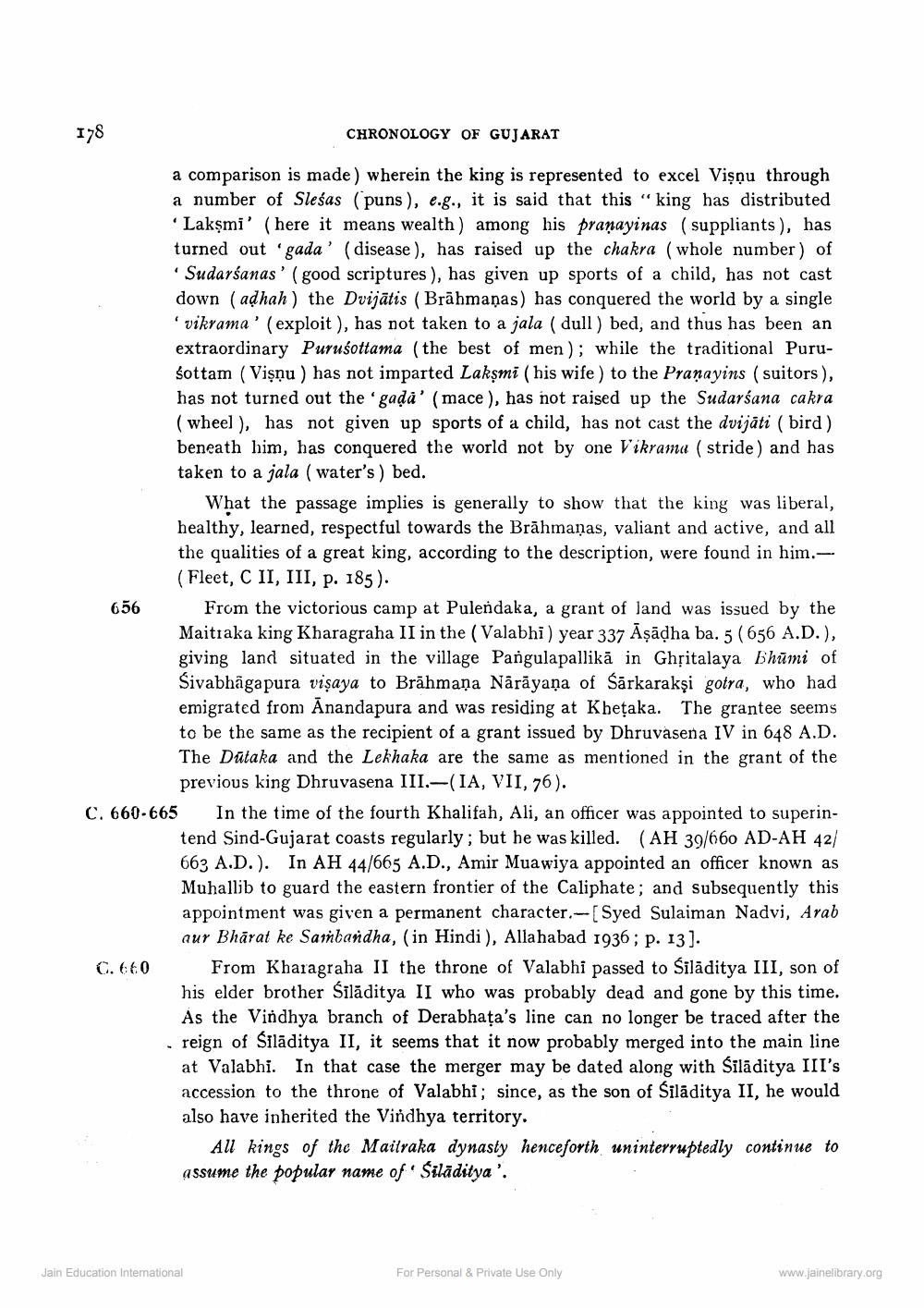________________
178
656
CHRONOLOGY OF GUJARAT
a comparison is made) wherein the king is represented to excel Vişņu through a number of Siešas (puns), e.g., it is said that this "king has distributed 'Laksmi (here it means wealth) among his pranayinas (suppliants), has turned out 'gada' (disease), has raised up the chakra (whole number) of 'Sudarsanas' (good scriptures), has given up sports of a child, has not cast down (adhah) the Dvijätis (Brahmanas) has conquered the world by a single 'vikrama' (exploit ), has not taken to a jala ( dull) bed, and thus has been an extraordinary Purusottama (the best of men); while the traditional PuruSottam (Visnu) has not imparted Lakṣmi (his wife) to the Pranayins (suitors), has not turned out the 'gada' (mace), has not raised up the Sudarsana cakra (wheel), has not given up sports of a child, has not cast the dvijati (bird) beneath him, has conquered the world not by one Vikrama ( stride) and has taken to a jala (water's) bed.
C. 660
What the passage implies is generally to show that the king was liberal, healthy, learned, respectful towards the Brahmanas, valiant and active, and all the qualities of a great king, according to the description, were found in him.(Fleet, C II, III, p. 185).
From the victorious camp at Pulendaka, a grant of land was issued by the Maitraka king Kharagraha II in the (Valabhi) year 337 Āṣādha ba. 5 (656 A.D.), giving land situated in the village Pangulapallikä in Ghritalaya Bhumi of Šivabhagapura visaya to Brahmana Narayana of Sarkarakşi gofra, who had emigrated from Anandapura and was residing at Khetaka. The grantee seems to be the same as the recipient of a grant issued by Dhruvasena IV in 648 A.D. The Dutaka and the Lekhaka are the same as mentioned in the grant of the previous king Dhruvasena III.-(IA, VII, 76).
C. 660-665
In the time of the fourth Khalifah, Ali, an officer was appointed to superintend Sind-Gujarat coasts regularly; but he was killed. (AH 39/660 AD-AH 42/ 663 A.D.). In AH 44/665 A.D., Amir Muawiya appointed an officer known as Muhallib to guard the eastern frontier of the Caliphate; and subsequently this appointment was given a permanent character.-[Syed Sulaiman Nadvi, Arab aur Bharat ke Sambandha, (in Hindi), Allahabad 1936; p. 13].
From Kharagraha II the throne of Valabhi passed to Siladitya III, son of his elder brother Siladitya II who was probably dead and gone by this time. As the Vindhya branch of Derabhata's line can no longer be traced after the reign of Siladitya II, it seems that it now probably merged into the main line at Valabhi. In that case the merger may be dated along with Siläditya III's accession to the throne of Valabhi; since, as the son of Siläditya II, he would also have inherited the Vindhya territory.
All kings of the Maitraka dynasty henceforth uninterruptedly continue to assume the popular name of Siladitya".
Jain Education International
For Personal & Private Use Only
www.jainelibrary.org




